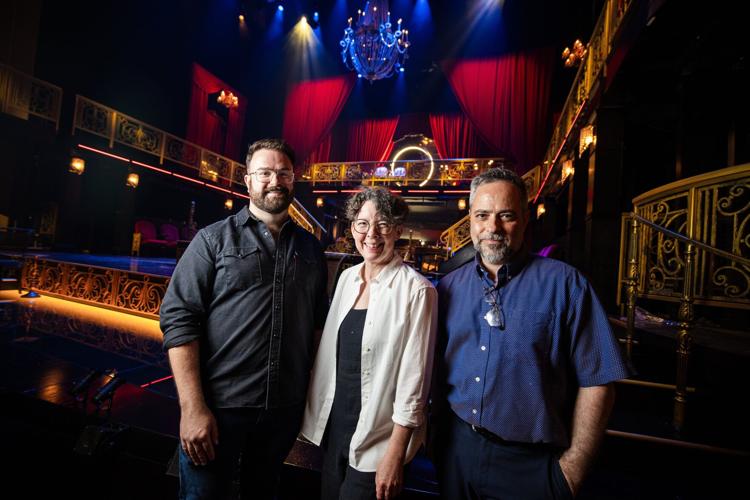One of Toronto’s biggest theatre hits is getting a bit of a Swiftie makeover.
When the Dora Award-winning ensemble of “Natasha, Pierre & the Great Comet of 1812” step onto the stage of the Royal Alexandra Theatre this month, they’ll literally be following in the footsteps of the world’s biggest pop star.
“One of the new elements of the design are these video floors you can walk on and we got them from the Taylor Swift Eras tour,” explained director Chris Abraham, who has overseen all the changes to his production of the Dave Malloy work.
Taylor had images of things like clouds and flames flashing under her feet. The videos in “Natasha, Pierre” will be fairly abstract, mostly illumination and shapes.
Not that the show — a completely sung-through musical based on a 70-page section from Leo Tolstoy’s massive 19th-century novel “War and Peace” — needs this flashy bit of star power to succeed.
After all, the original Crow’s Theatre show, a co-production with Musical Stage Company, broke all records as the longest running and most successful staging in the company’s history. It opened right before Christmas 2023 and got extended more than half a dozen times into the spring.
But this element is one of many that Abraham and his design team — which includes set designers Julie Fox and Joshua Quinlan, who won Doras for their work on the show — have used in transferring the show from the 200-seat space at Crow’s to the 1,100-plus-seat Royal Alex.

The original Crow’s Theatre staging of “Natasha, Pierre & the Great Comet of 1812” was inspired by 19th-century European opera houses and featured boxes where musicians and actors played out scenes.
Dahlia KatzThe original Crow’s staging was inspired by 19th-century European opera houses, much like the kind the Royal Alex was modelled after. It featured red velvety curtains and elegant chandeliers. As I wrote in my original Star rave review, the production felt “simultaneously grand and intimate.”
Crow’s Guloien Theatre doesn’t feature boxes, but Fox and Quinlan designed and installed them, and they became an integral part of the show where musicians and actors played out scenes, adding physical height and a sense of elegance.
Height, elegance and chandeliers are all things, of course, that the Royal Alex already possesses. Coincidentally, the traditional red plush seats of the historic house perfectly match the red curtains from the Crow’s staging.
“The first thing we wondered when we found out about the transfer was how we were going to recreate the experience and adventure of being in this world, so audiences wouldn’t feel like there was a gulf between them and the stage,” said Fox, during a walkabout tour of the theatre with its new set.
They’ve achieved that partly by creating what they call balconettes, which wrap around the outside of the theatre’s proscenium stage and connect the actual boxes on either side of the dress circle with two staircases.
“We’ve sort of dissolved the fourth wall scenically,” said Fox. “The people in the boxes have access to the performers because they’re almost at the same level, which is really unusual in the theatre.”

Joshua Quinlan, Chris Abraham and Julie Fox show off the Royal Alexandra set of “Natasha, Pierre & the Great Comet of 1812,” which includes seats on the stage and balconettes.
Nick Lachance/Toronto StarQuinlan adds: “Normally, a box seat isn’t an ideal place to see a show from because you’re kind of looking into the wings. In this case, you’ve got a really interesting vantage point for what’s happening.”
And those Taylor Swift light boxes? They’ll add another visual element for people sitting in the balcony to appreciate looking down at the stage.
Abraham, Fox and Quinlan led me to the front of the stage, which feels surprisingly close to the balcony.
It’s hard to believe, but the width of the Royal Alex stage is smaller than the one at Crow’s.
“We’ve lost about 10 feet of width,” said Quinlan. Immersive onstage seating, some of which will be released daily as rush tickets, will include one row of plush seats and one row of stools on either side of the main playing area.
One of the signature elements of the Crow’s staging was a raised square area that, when pushed by actors, revolved, suggesting movement and the passing of time.
“We had deliberated about automating that revolve, but in the end decided it was better for it to be moved by the performers,” explained Fox. “It’s more sensitive to the action and expresses the subjective experience of the whirlwind of things that happen to Natasha (the musical’s heroine) when she goes to Moscow. It makes the staging more dynamic and keeps the stage picture fresh.”
Crow’s artistic director Abraham recalls seeing the earliest version of Molloy’s show at the tiny off-Broadway Ars Nova space before it transferred to the massive Imperial Theatre on Broadway.
“It began in a small venue and then transferred to bigger houses but, at every step of its growth, it never became a show about the location,” said Abraham. “What has always been fundamental was the relationship between the performer and the audience. And we’ve maintained that here.”
Designing and directing a production like this is one thing, but how does it feel to be walking on its stages, and ascending and descending its stairs eight times a week?

Left, Divine Brown with Camille Eanga-Selenge, Hailey Gillis and George Krissa in the original “Natasha, Pierre.” Brown says she loves “the intimacy of the audience.”
Dahlia Katz“I love the intimacy of the audience and being able to engage with people at any given moment,” said actor and Juno Award-winning R&B singer Divine Brown, who plays one of the musical’s two villainous characters, Helene, who’s married to the hero, Pierre.
“Acting and singing are all storytelling. And this kind of intimacy between actor and audience just elevates the storytelling.”
(Besides Brown, cast members Hailey Gillis, Evan Buliung, George Krissa, Louise Pitre, Marcus Nance and Lawrence Libor are returning to the show, joined by new cast member Vanessa Sears.)
Abraham and his designers are used to modifying the sets of their more successful shows for other stages. His production of “Uncle Vanya” began life as an in-the-round production for Crow’s. But co-set designers Fox and Quinlan modified it for proscenium stagings at Theatre Aquarius and the CAA Theatre. Individually, Fox and Quinlan have adjusted their sets for “Fifteen Dogs” and “The Master Plan” for other spaces.
“You have to think how a play can live in a new space in the best way,” said Fox. “You have to exploit all the good things about a particular theatre. ‘Fifteen Dogs’ took place in an urban environment, for instance, and there was something quasi-industrial about the CAA Theatre space.”
Having access to Mirvish subscribers — who make up the biggest theatre subscription series in the city — is invaluable. In this tough economic time for the arts, it’s a great way to build brand recognition.
“We’ve seen a dramatic increase in our subscribers and our audiences over the last couple of years, partly because of our extensions in the off-Mirvish season,” said Abraham.
“The Mirvish audience member has changed a lot, even in the past five years. It’s much younger and more diverse. People go to a Mirvish show to see a show that they don’t want to miss. It’s no accident that we’re programming this show now and following it up with another Dave Malloy piece (‘Octet’) at Crow’s in September.”
“Natasha, Pierre and the Great Comet of 1812” begins previews Tuesday and runs to Aug. 24 at the Royal Alexandra Theatre, 260 King St. W. See mirvish.com for information.
Correction — July 16, 2025
This story has been edited from an earlier version that misnamed the Royal Alexandra Theatre in one reference.



































To join the conversation set a first and last name in your user profile.
Sign in or register for free to join the Conversation